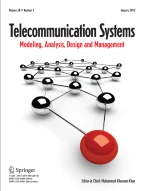Abstract
Looking at the ever-increasing amount of heterogeneous distributed applications supported on current data transport networks, it seems evident that best-effort packet delivery falls short to supply their actual needs. Multiple approaches to Quality of Service (QoS) differentiation have been proposed over the years, but their usage has always been hindered by the rigidness of the TCP/IP-based Internet model, which does not even allow for applications to express their QoS needs to the underlying network. In this context, the Recursive InterNetwork Architecture (RINA) has appeared as a clean-slate network architecture aiming to replace the current Internet based on TCP/IP. RINA provides a well-defined QoS support across layers, with standard means for layers to inform of the different QoS guarantees that they can support. Besides, applications and other processes can express their flow requirements, including different QoS-related measures, like delay and jitter, drop probability or average traffic usage. Greedy end-users, however, tend to request the highest quality for their flows, forcing providers to apply intelligent data rate limitation procedures at the edge of their networks. In this work, we propose a new rate limiting policy that, instead of enforcing limits on a per QoS class basis, imposes limits on several independent QoS dimensions. This offers a flexible traffic control to RINA network providers, while enabling end-users freely managing their leased resources. The performance of the proposed policy is assessed in an experimental RINA network test-bed and its performance compared against other policies, either RINA-specific or adopted from TCP/IP. Results show that the proposed policy achieves an effective traffic control for high QoS traffic classes, while also letting lower QoS classes to take profit of the capacity initially reserved for the former ones when available.
Similar content being viewed by others
Explore related subjects
Discover the latest articles, news and stories from top researchers in related subjects.References
Chen, Y., Farley, T., & Ye, N. (2004). QoS requirements of network applications on the internet. Information Knowledge Systems Management, 4(1), 55–76.
Trouva, E., Grasa, E., Day, J., Matta, I., Chitkushev, L. T., Phelan, P., & Bunch, S. (2011). Is the internet an unfinished demo? Meet RINA!. In TERENA networking conference (TNC) 2011, Prague, Czech Republic.
Day, J., Matta, I., & Mattar, K. (2008). Networking is IPC: A guiding principle to a better internet. In 4th international conference on emerging networking experiments and technologies (ACM CoNEXT) 2008, New York, USA, (pp. 1–6).
FP7 PRISTINE (2013) Deliverable 3.2 Initial specification and proof of concept implementation of techniques to enhance performance and resource utilization in networks, (pp. 39–55). http://ict-pristine.eu/wp-content/uploads/2013/12/pristine_d33_draft.pdf.
Davies, N., (2003) Delivering predictable quality in saturated networks. Technical Report. http://www.pnsol.com/public/TP-PNS-2003-09.pdf.
Davies, N., Holyer, J., & Thompson, P. (1999). An operational model to control loss and delay of traffic in a network switch. In 3th IFIP workshop on traffic management and design of ATM networks.
Davies, N., Holyer, J., & Thompson, P. (1999). A queueing theory model that enables control of loss and delay at a network switch. Technical Report, University of Bristol, Bristol, United Kingdom, 1999.
Kesselman, A., Leonardi, S., & Bonifaci, V. (2005). Game-theoretic analysis of internet switching with selfish users. In Internet and network economics (WINE) 2005, Hong Kong, China, (pp. 236–245).
Day, J. (2008). Patterns in network architecture: A return to fundamentals. Upper Saddle River: Prentice Hall.
Grasa, E., Gastn, B., van der Meer, S., Crotty, M., & Puente, M. A. (2016). Simplifying multi-layer network management with RINA. In TERENA networking conference (TNC), Prague, Czech Republic.
IRATI FP7-317814. Researching and Prototyping the recursive InterNetwork architecture to support distributed computing. http://irati.eu.
PRISTINE FP7-619305. Programmability in RINA for European supremacy of virtualized networks. http://ict-pristine.eu.
ARCFIRE H2020-687871. Experimenting RINA on FIRE+. http://ict-arcfire.eu.
Maffione, V., Salvestrini, F., Grasa, E., Bergesio, L., & Tarzan, M. (2016). A software development kit to exploit RINA programmability. In Next generation networking and internet symposium (IEEE ICC) 2016, Kuala Lumpur, Malaysia.
GitHub - IRATI/stack: RINA implementation for OS/Linux. https://github.com/IRATI/stack.
Leon, S., Perelló, J., Careglio, D., Grasa, E., Davies, N. J., Thompson, P., (2016) Assuring QoS guarantees for heterogeneous services in RINA networks with ΔQ. In Workshop on network infrastructure services as part of cloud computing (NetCloud) 2016, Luxembourg.
Predictable network Solutions Limited. (2015). A study of traffic management detection methods and tools. United Kingdom: OfCom.
Almquist, P., (1992). Type of service in the internet protocol suite. RFC 1349, https://doi.org/10.17487/rfc1349, https://www.rfc-editor.org/info/rfc1349.
Nadeem, R. M., Saleem, R. M., Bashir, R. N., & Habib, S. (2017). Analysis of impact of differentiated services (DiffServ) on the quality of services (QoS) Parameters of major services of internet. Indian Journal of Science & Technology, 10(31), 1–24.
Mermelstein, P. (1988). G.722: A new CCITT coding standard for digital transmission of wideband audio signals. IEEE Communications Magazine, 26(1), 8–15.
Youtube: Live encoder settings, bitrates, and resolutions. https://support.google.com/youtube/answer/2853702.
ISO/IEC/IEEE International Standard for Ethernet. (2014). In ISO/IEC/IEEE 8802-3:2014(E) (pp. 1–3754). https://doi.org/10.1109/IEEESTD.2014.6781545.
Acknowledgements
This work has been partially supported by the Spanish Ministry of Economy and Competitiveness under contract TEC2017-90034-C2-1-R (ALLIANCE Project) that receives funding from FEDER and by the European Commission through the H2020 ARCFIRE project (Grant 687871).
Author information
Authors and Affiliations
Corresponding author
Ethics declarations
Conflict of interest
All the authors declare that they have no conflict of interest.
Rights and permissions
About this article
Cite this article
Leon Gaixas, S., Perelló, J., Careglio, D. et al. End-user traffic policing for QoS assurance in polyservice RINA networks. Telecommun Syst 70, 365–377 (2019). https://doi.org/10.1007/s11235-018-0489-2
Published:
Issue Date:
DOI: https://doi.org/10.1007/s11235-018-0489-2
